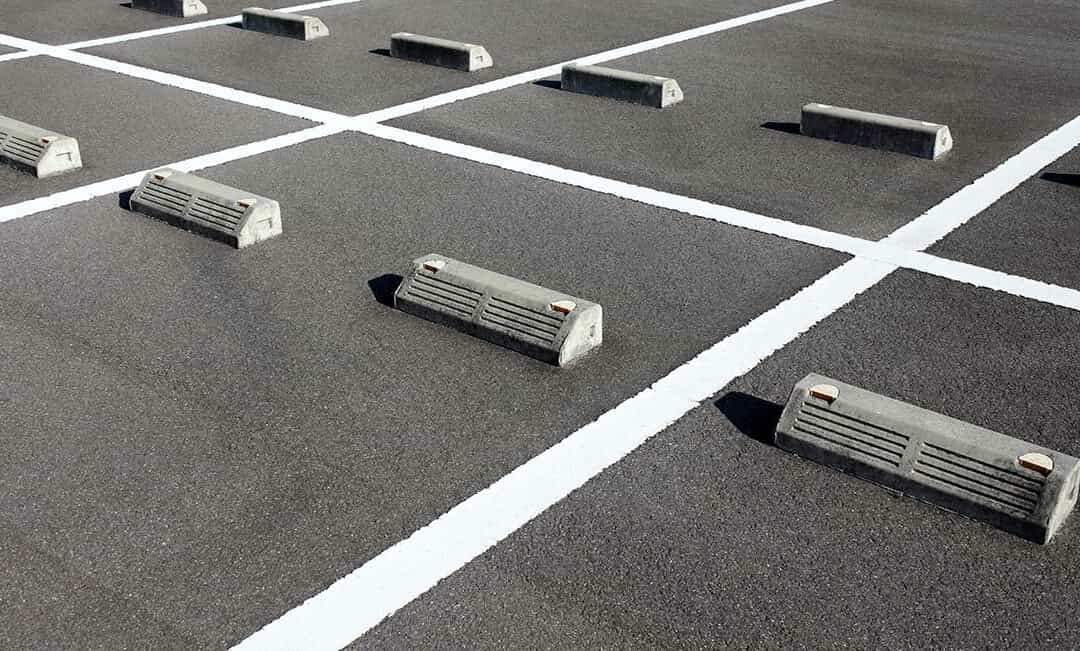Aircraft carriers have arresting cables that help prevent jets from taxiing over the deck and fall overboard. In parking facilities, wheel stops serve the same function: to keep a vehicle from going beyond its allotted parking space and cause damage or injuries.
Wheel stops are also called parking blocks, tire stoppers, wheel stoppers, and curb stops. They are usually found on parking lots, car parks, medical facilities, shopping areas, garages for rent, and other establishments that offer temporary and long-term parking. Regardless of what they are called, wheel stops act as barriers and prevent a vehicle from driving over or coasting beyond the designated parking slot onto sidewalks, accessible ramps, or adjacent stalls in case the driver fails to put on the hand or floor brakes on time. The main purpose of these barriers is to ensure safety for the vehicle, passing pedestrians, and the property itself (in cases where parking spots are located near walls, fences, or landscaping and foliage).
Parking wheel stops are made using four major materials: concrete, rubber, plastic and metal. However, the most popular are either concrete or rubber as they are the most economical and practical options in a long-term perspective. Although both options serve the same purpose, there are certain advantages and disadvantages to be considered before choosing the best wheel stop material to be installed in your parking facility, truck stop, garage, or impound lot.
Durability and Longevity
Concrete wheel stops can be installed both indoors and outdoors. One huge advantage of concrete wheel stops compared to other materials is they are very heavy. Due to this, concrete stops are very stable once secured into place and would do a very good job of barricading vehicles from going over their designated parking spots. In addition, concrete barriers can be very durable and long-lasting, especially when installed indoors, as they are protected from exposure to the elements. So long as the concrete stoppers are not water-logged, they can last for a long time. However, one of the major cons of concrete wheel stops is that, if they are installed outdoors and get constantly exposed to the sun, rain, snow and other natural elements, they grow weak over time. Once weakened, the concrete wheel stop can get chipped and cracked from repeated contact with vehicle wheels.
Rubber wheel stops are also ideal for indoor and outdoor parking installations. One major takeaway is that since the material is resistant to UV rays, moisture, oil and chemical spills, and extreme weather conditions, rubber stoppers are generally preferred for outdoor parking facilities as they are more durable compared to concrete and do not chip or crack even with repeated impacts.
Installation
Concrete wheel blocks are usually pre-cast and ready to install by the time they are delivered to the site. To install, the slab of concrete stopper is placed on its intended setting and marks are placed to correspond with the wheel stop’s fixings. Holes are then drilled into the pavement, and the concrete wheel stop is placed back on its intended setting. Depending on manufacturer’s specifications, the fixings are either metal rebar, galvanized pins, metal bolts or concrete epoxy. Once installed, concrete wheel stops do not budge easily, which is a major advantage.
However, weight also becomes a disadvantage with concrete wheel stops. Since these concrete slabs weigh at least 100 lbs., they are really heavy. It will need 2 to 3 people to install each wheel stop. In a parking lot with a minimum of 50 stalls, this can prove to be time-consuming. In a larger facility with hundreds of parking slots, heavy machinery might be required to ship, deliver, and install all wheel stops needed.
For rubber wheel stops, installation and fixings vary according to the manufacturer. However, these parking blocks are relatively easier to handle and install compared to its concrete counterpart – mainly due to the lighter weight. The average weight of a rubber wheel stop is only 30 lbs. To install a rubber wheel stop, you’ll need a power drill with a 14mm or 16mm drill bit (or depending on the actual size of the spikes or metal fasteners included in the kit), a large hammer, and a bristle broom or portable vacuum.
Just like with concrete wheel stops, the rubber stoppers also need to be installed on a flat surface. You will also need to drill a hole to mark where the fixings will be inserted. Once that is done, remove the wheel stop and continue drilling on the guide hole until the specified depth is reached. Place the rubber wheel stop back on the intended spot, making sure that the holes on the stopper are aligned with the ones you drilled on the pavement. Insert the spikes and hammer down until set. Continue brushing or vacuuming any accumulated dust. Since rubber wheel stops are more lightweight compared to concrete, they can be easily installed by 1 person.
Colors
Concrete wheel stops can be painted with appropriate colors – black and yellow diagonal stripes for regular parking, blue and white for handicap parking, red (or intersperse with white) for reserved parking (such as for ambulances, fire trucks, law enforcement, and other emergency vehicles in medical facilities, hospitals, police stations, and the like). This is one major advantage of a concrete wheel stop compared to its rubber counterpart. It can be easily repainted and customized as needed.
However, with extended exposure to outdoor elements, paint can peel and/or fade over time. This means that in order to maintain visibility, concrete wheel stops should be repainted on a regular basis.
Rubber wheel stops are usually pre-cast with reflective tape or paint before getting delivered to the site. This is an advantage, since you won’t have to spend extra money for paint, and the colors don’t fade through the years, even when continuously exposed to the elements.
One disadvantage of rubber wheel stops is that, most companies only offer the black and yellow option. Since the colors are specific when you purchase them, if you need to convert a regular parking spot into a handicap or reserved/emergency parking, you will need to remove the black and yellow stopper and replace it with one that has the appropriate color(s). Some companies sell blue and white rubber wheel stops for handicap parking, however, the red and white ones for emergency parking can be very rare, as not all manufacturers offer this option.
Environmental Impact
Concrete wheel stops do not really have an environmental impact, since they do not harm nor help the environment in any way. Since there are no toxic elements contained in concrete, when a wheel stop gets eroded and crumbles over time, the particles will just turn to dust.
Rubber wheel stops are made from 100% recycled tires, so they are also considerably environment-friendly.
Cost
Concrete wheel stops are very inexpensive compared to rubber. On the other hand, since rubber wheel stops are recycled tires, the processing and manufacturing makes it more expensive.
On a closing note, concrete wheel stops, although inexpensive, can be quite difficult to transport and install due to their weight. However, they are ideal for indoor parking facilities and can be painted and customized. Aside from the regulatory diagonal stripes, concrete wheel stops can also be painted with words using stencils.
Rubber wheel stops are highly recommended for outdoor parking due to the material’s resistance to most weather conditions. Since rubber is lightweight, the wheel stops can be easily installed by one person. On the other hand, they are more expensive and cannot be customized or repainted since they are already pre-cast with colored or reflective tape.



